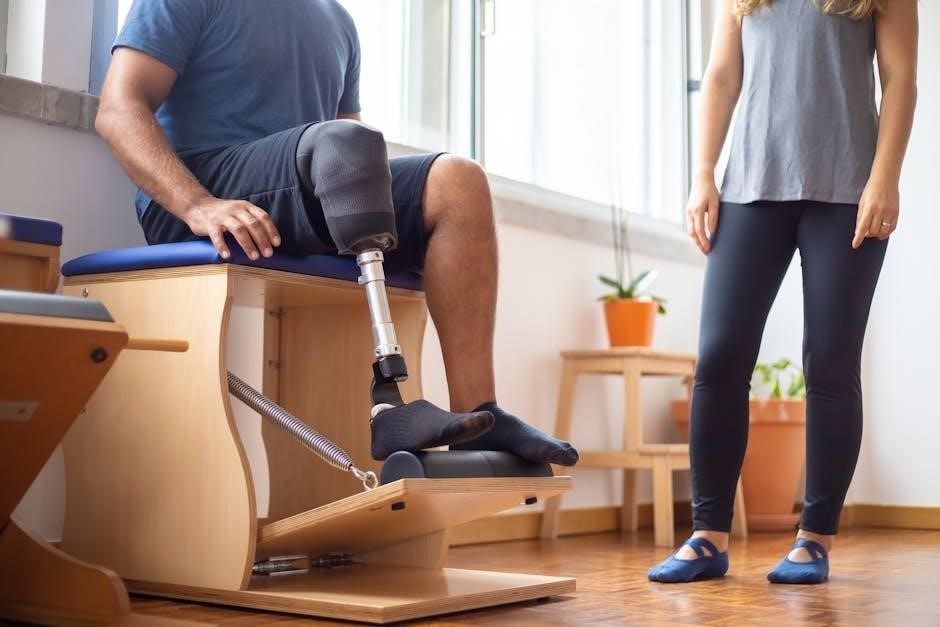Myofunctional therapy is a program of specific exercises targeting facial muscles used in chewing and swallowing, strengthening them to improve oral function and overall well-being.
What is Myofunctional Therapy?
Myofunctional therapy is a non-invasive program of targeted exercises designed to strengthen and retrain the muscles of the face, mouth, and tongue. It focuses on improving orofacial muscle function to address issues like swallowing disorders, breathing difficulties, and orthodontic problems. These exercises aim to enhance muscle tone, coordination, and overall oral motor skills, promoting proper chewing, swallowing, and breathing patterns. Regular practice can lead to long-term improvements in facial structure and respiratory stability, making it a versatile treatment for various health concerns.
Importance of Facial and Oral Muscle Training
Facial and oral muscle training is essential for maintaining proper muscle function, which directly impacts chewing, swallowing, and breathing. Weak or poorly coordinated muscles can lead to issues like sleep apnea, orthodontic problems, and swallowing disorders. Strengthening these muscles through targeted exercises improves muscle tone, enhances coordination, and supports overall oral motor function. This training also addresses tongue thrust habits and promotes proper nasal breathing, leading to better respiratory stability and improved posture. Regular practice ensures long-term benefits for oral health and overall well-being.

Benefits of Myofunctional Therapy Exercises
Myofunctional therapy strengthens facial and oral muscles, improving chewing, swallowing, and breathing. It enhances upper airway stability, addressing tongue thrust and sleep apnea, promoting better overall function.
Improving Swallowing and Chewing Functions
Myofunctional therapy exercises enhance swallowing and chewing by strengthening the muscles involved in these processes. Techniques like tongue presses, slides, and gum chewing improve coordination and muscle tone, reducing swallowing difficulties. These exercises also address issues like tongue thrust, promoting proper oral function and better overall chewing efficiency.
Enhancing Airway Stability for Better Breathing
Myofunctional therapy exercises strengthen the upper airway muscles, improving stability and reducing collapse. Techniques like tongue slides, stretches, and deep breathing enhance nasal breathing and promote proper airflow. These exercises increase muscle tone, leading to better breathing patterns and reduced symptoms of conditions like sleep apnea. By targeting the tongue and facial muscles, therapy improves airway support, ensuring more efficient and stable breathing during rest and activity.
Addressing Tongue Thrust and Orthodontic Issues
Myofunctional therapy exercises help correct tongue thrust habits by strengthening muscles, improving tongue posture, and enhancing swallowing patterns. These exercises, such as tongue slides and stretches, promote proper alignment of the tongue and facial muscles. By addressing muscle imbalances, therapy supports orthodontic treatment outcomes, reducing the risk of relapse. Strengthening the tongue and surrounding muscles also aids in achieving optimal dental alignment and long-term stability, benefiting both oral function and aesthetic results.

Key Concepts in Myofunctional Therapy
Myofunctional therapy involves exercises targeting the tongue, facial muscles, and swallowing mechanisms to improve oral function and posture, addressing muscle imbalances through specific techniques.
Understanding the Role of the Tongue and Facial Muscles
The tongue and facial muscles play a crucial role in myofunctional therapy. The tongue, a voluntary muscle, influences chewing, swallowing, and breathing. Weakness or poor posture can lead to issues like tongue thrust and speech problems. Facial muscles, including those around the mouth and jaw, work in harmony with the tongue to maintain proper oral function. Strengthening these muscles through targeted exercises can improve posture, reduce airway collapse, and enhance overall facial aesthetics, leading to better oral health and functionality.
Difference Between Isotonic and Isometric Exercises
In myofunctional therapy, isotonic exercises involve muscle contractions with movement, enhancing coordination and dynamic strength. Isometric exercises involve holding contractions without movement, building endurance and stability. Both are essential for a comprehensive regimen, with isotonic improving functionality and isometric strengthening muscles for sustained tasks.

Common Myofunctional Therapy Exercises
Common exercises include tongue slides, stretches, and resistance training to strengthen facial and oral muscles, improving function and posture through targeted movements and resistance techniques.
Foundational Exercises
Foundational exercises in myofunctional therapy focus on awakening and strengthening oral and facial muscles. These include tongue slides, stretches, and gentle resistance tasks. Tongue slides involve pressing the tongue tip behind the front teeth and sliding it back. Tongue stretches enhance flexibility, while gum chewing strengthens jaw muscles. These exercises improve muscle tone, coordination, and awareness, laying the groundwork for advanced techniques. Consistency is key to building a strong foundation for addressing issues like tongue thrust and improving swallowing and breathing functions effectively.
Tongue Stretch and Slide Techniques
Tongue stretch and slide techniques are essential in myofunctional therapy to enhance flexibility and coordination. The tongue slide involves placing the tip behind the front teeth and sliding it back gently. Tongue stretches require extending the tongue as far as possible, holding it for a few seconds; These exercises improve range of motion, reduce tension, and strengthen the tongue muscles. Regular practice promotes better swallowing, chewing, and breathing, while addressing issues like tongue thrust and airway instability for improved oral function and overall well-being.

Advanced Resistance and Strengthening Exercises
Advanced resistance and strengthening exercises in myofunctional therapy build on foundational techniques, incorporating tools like spoons or resistance devices. Exercises such as the tongue press against the palate or cheek resistance strengthen the tongue and facial muscles. These activities improve muscle tone, endurance, and coordination, addressing issues like sleep apnea or orthodontic problems. Regular practice enhances airway stability, chewing efficiency, and overall oral function, promoting long-term benefits for breathing, speaking, and swallowing abilities. Consistency is key to achieving lasting results.

Breathing Techniques in Myofunctional Therapy
Deep breathing exercises, such as nasal breathing with tongue touch, promote relaxation and strengthen upper airway muscles, enhancing overall breathing efficiency and stability.
Deep Breathing Exercises for Nasal Breathing
Deep breathing exercises in myofunctional therapy involve sitting straight with mouth closed and jaw relaxed, inhaling through the nose, and exhaling slowly. These exercises strengthen upper airway muscles and improve nasal breathing efficiency. The tongue is often placed on the upper palate to enhance airflow and stability. Regular practice promotes relaxation and can reduce upper airway collapse, aiding in conditions like sleep apnea. Consistency is key to achieving long-term benefits for respiratory and overall oral function.

Tongue Touch and Relaxation Techniques
Tongue touch and relaxation techniques involve placing the tongue on the upper palate and breathing nasally to promote airway stability. These exercises help eliminate tongue thrusting habits and improve swallowing. Regular practice relaxes facial muscles, enhances tongue strength, and supports proper oral posture. By focusing on deep breathing with the tongue in position, individuals can achieve better respiratory function and overall muscle tone, reducing upper airway collapse and improving sleep quality over time.

Tracking Progress and Consistency
Tracking progress involves regular practice and awareness of improvements in muscle tone and function, ensuring consistent effort to achieve long-term benefits from myofunctional therapy exercises.
Weekly Exercise Routines and Goals
A structured weekly routine is essential for myofunctional therapy success. Begin with simple exercises like tongue slides and stretches, progressing to resistance training. Week 1 focuses on awakening muscles, while Week 2 introduces tongue tip resistance. Perform exercises 3-5 times daily, with 5-10 repetitions each. Goals include improving muscle tone, strength, and coordination. Consistency is key to achieving long-term benefits, such as enhanced swallowing, breathing, and posture. Adjust routines as progress is observed, ensuring gradual muscle adaptation and functional improvement.
Monitoring Muscle Tone and Strength Improvement
Regular assessment of muscle tone and strength is crucial in myofunctional therapy. Use specific exercises to gauge progress, such as tongue resistance and swallowing efficiency. Observe improvements in posture, breathing, and facial muscle coordination. Track changes in swallowing patterns and airway stability over time. A therapist can evaluate muscle function and adjust routines accordingly. Consistent monitoring ensures tailored progression and maximizes therapeutic outcomes, helping achieve optimal muscle function and long-term benefits.

Real-World Applications of Myofunctional Therapy
Myofunctional therapy is widely used to address sleep apnea, support orthodontic treatment, and improve swallowing disorders, offering practical solutions for enhanced breathing and oral function in daily life.
Exercises for Sleep Apnea and Upper Airway Stability
Myofunctional therapy exercises targeting the tongue and upper airway muscles can significantly improve sleep apnea symptoms. Techniques like tongue slides and resistance exercises strengthen the muscles, reducing airway collapse. Deep breathing exercises with tongue touch promote nasal breathing and relaxation, enhancing upper airway stability. Regular practice of these exercises helps improve airflow during sleep, reducing apneic events and improving overall sleep quality. These exercises are non-invasive and offer a sustainable solution for managing sleep apnea and related breathing difficulties.
Therapeutic Benefits for Orthodontic and Speech Issues
Myofunctional therapy exercises offer significant benefits for orthodontic and speech challenges. By strengthening tongue and facial muscles, these exercises can correct tongue thrust habits, improving orthodontic alignment. Enhanced muscle tone supports clearer speech articulation, addressing issues like lisps or mumbling. Additionally, proper swallowing mechanics are developed, reducing the risk of orthodontic relapse. These exercises create a balanced oral environment, fostering long-term improvements in both facial structure and communication abilities, making them a valuable complement to traditional orthodontic treatments.
Myofunctional therapy exercises provide lasting benefits, improving oral function, breathing, and speech. Consistent practice strengthens facial and tongue muscles, enhancing overall quality of life and well-being.

The Long-Term Impact of Myofunctional Therapy Exercises
Myofunctional therapy exercises yield lasting improvements in oral and facial muscle function, enhancing swallowing, breathing, and speech. Over time, they strengthen facial and tongue muscles, reducing issues like sleep apnea and orthodontic problems. Consistent practice promotes better airway stability, improving overall respiratory health. These exercises also contribute to proper facial development and posture, leading to long-term benefits for oral function, facial aesthetics, and quality of life, making them a valuable investment in lasting well-being.